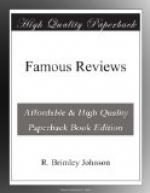I see no difficulty in supposing that such links formerly existed, and that each had been formed by the same steps as in the case of the less perfectly gliding squirrels, and that each grade of structure was useful to its possessor. Nor can I see any insuperable difficulty in further believing it possible that the membrane-connected fingers and forearm of the galeopithecus might be greatly lengthened by natural selection, and this, as far as the organs of flight are concerned, would convert it into a bat.—p. 181.
For instance, a swim-bladder has apparently
been converted into an
air-breathing lung.—p. 181.
And again:—
The electric organs of fishes offer another case of special difficulty: It is impossible to conceive by what steps these wondrous organs have been produced; but, as Owen and others have remarked, their intimate structure closely resembles that of common muscle; and as it has lately been shown that rays have an organ closely analogous to the electric apparatus, and yet do not, as Matteucci asserts, discharge any electricity, we must own that we are far too ignorant to argue that no transition of any kind is possible.—pp. 192-3.
Sometimes Mr. Darwin seems for a moment to recoil himself from this extravagant liberty of speculation, as when he says, concerning the eye,—
To suppose that the eye, with its inimitable contrivances for adjusting the focus to different distances, for admitting different amounts of light, and for the correction of spherical and chromatic aberration, could have been formed by natural selection, seems, I freely confess, absurd in the highest possible degree.—p. 186.
But he soon returns to his new wantonness of conjecture, and, without the shadow of a fact, contents himself with saying that—
he suspects that any sensitive
nerve may be rendered sensitive to
light, and likewise to those coarser vibrations
of the air which
produce sound.—p-187.
And in the following passage he carries this extravagance to the highest pitch, requiring a licence for advancing as true any theory which cannot be demonstrated to be actually impossible:—
If it could be demonstrated that any complex organ existed, which could not possibly have been formed by numerous, successive, slight modifications, my theory would absolutely break down. But I can find no such case.—p. 189.
Another of these assumptions is not a little remarkable. It suits his argument to deduce all our known varieties of pigeons from the rock-pigeon (the Columba livia), and this parentage is traced out, though not, we think, to demonstration, yet with great ingenuity and patience. But another branch of the argument would be greatly strengthened by establishing the descent of our various breeds of dogs with their perfect power of fertile




